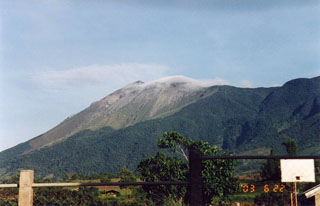Report on Kanlaon (Philippines) — 12 May-18 May 2010
Smithsonian Institution / US Geological Survey
Weekly Volcanic Activity Report, 12 May-18 May 2010
Managing Editor: Sally Sennert.
Please cite this report as:
Global Volcanism Program, 2010. Report on Kanlaon (Philippines) (Sennert, S, ed.). Weekly Volcanic Activity Report, 12 May-18 May 2010. Smithsonian Institution and US Geological Survey.
Kanlaon
Philippines
10.4096°N, 123.13°E; summit elev. 2422 m
All times are local (unless otherwise noted)
Based on a pilot observation, the Tokyo VAAC reported that on 15 May an ash plume from Kanlaon rose to an altitude of 2.4 km (8,000 ft) a.s.l. and drifted W. Ash was not identified in satellite imagery. [PHIVOLCS later confirmed that the plume originated from a fire and not an eruption. Monitored parameters for Kanlaon indicated normal levels and the Alert Level remained at 0 (on a scale of 0-5).]
Geological Summary. Kanlaon volcano (also spelled Canlaon) forms the highest point on the Philippine island of Negros. The massive andesitic stratovolcano is covered with fissure-controlled pyroclastic cones and craters, many of which are filled by lakes. The largest debris avalanche known in the Philippines traveled 33 km SW from Kanlaon. The summit contains a 2-km-wide, elongated northern caldera with a crater lake and a smaller but higher active vent, Lugud crater, to the south. Eruptions recorded since 1866 have typically consisted of phreatic explosions of small-to-moderate size that produce minor local ashfall.

